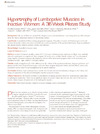Identificador persistente para citar o vincular este elemento:
https://accedacris.ulpgc.es/jspui/handle/10553/72756
| Título: | Hypertrophy of Lumbopelvic Muscles in Inactive Women: A 36-Week Pilates Study | Autores/as: | Dorado García, Cecilia López-Gordillo, Ana Serrano Sánchez, José Antonio López Calbet, José Antonio Sanchís Moysi, Joaquín |
Clasificación UNESCO: | 241106 Fisiología del ejercicio | Palabras clave: | Hypertrophy Magnetic Resonance Imaging Muscle Pilates-Based Exercises |
Fecha de publicación: | 2020 | Publicación seriada: | Sports Health | Resumen: | Background: The use of Pilates in various fields of sport sciences and rehabilitation is increasing; however, little is known about the muscle adaptations induced by this training method. Hypothesis: A standardized Pilates training program for beginners (9 months; 2 sessions of 55 minutes per week) will increase the muscle volume and reduce potential side-to-side asymmetries of the quadratus lumborum, iliopsoas, piriformis, and gluteus muscles (gluteus maximus, medius, and minimus). Study Design: Controlled laboratory study. Level of Evidence: Level 3. Method: A total of 12 inactive, healthy women (35.7 ± 5.4 years) without previous experience in Pilates were randomly selected to participate in a supervised Pilates program (36 weeks, twice weekly). Muscle volume (cm3) was determined using magnetic resonance imaging at the beginning and end of the intervention program. Side-to-side asymmetry was calculated as [(left – right volume) × 100/right volume]. Results: Small, nonsignificant (P > 0.05) differences in the volume of the quadratus lumborum, iliopsoas, piriformis, and gluteus muscles were observed between pre– and post–Pilates program timepoints. Before and after Pilates, side-to-side asymmetry was less than 6% and nonsignificant in all muscles analyzed. Conclusion: Modern Pilates performed twice weekly for 9 months did not elicit substantial changes in the volume and degree of asymmetry of the selected lumbopelvic muscles in inactive women. Clinical Relevance: The benefits of Pilates in rehabilitation or training are likely elicited by neuromuscular rather than morphological adaptations. Pilates has no significant impact on muscle volume and does not alter side-to-side ratios in muscle volume (degree of asymmetry) of the lumbopelvic muscles. | URI: | https://accedacris.ulpgc.es/handle/10553/72756 | ISSN: | 1941-7381 | DOI: | 10.1177/1941738120918381 | Fuente: | Sports Health [ISSN 1941-7381], v. 12(6), p. 547-551 |
| Colección: | Artículos |
Los elementos en ULPGC accedaCRIS están protegidos por derechos de autor con todos los derechos reservados, a menos que se indique lo contrario.
